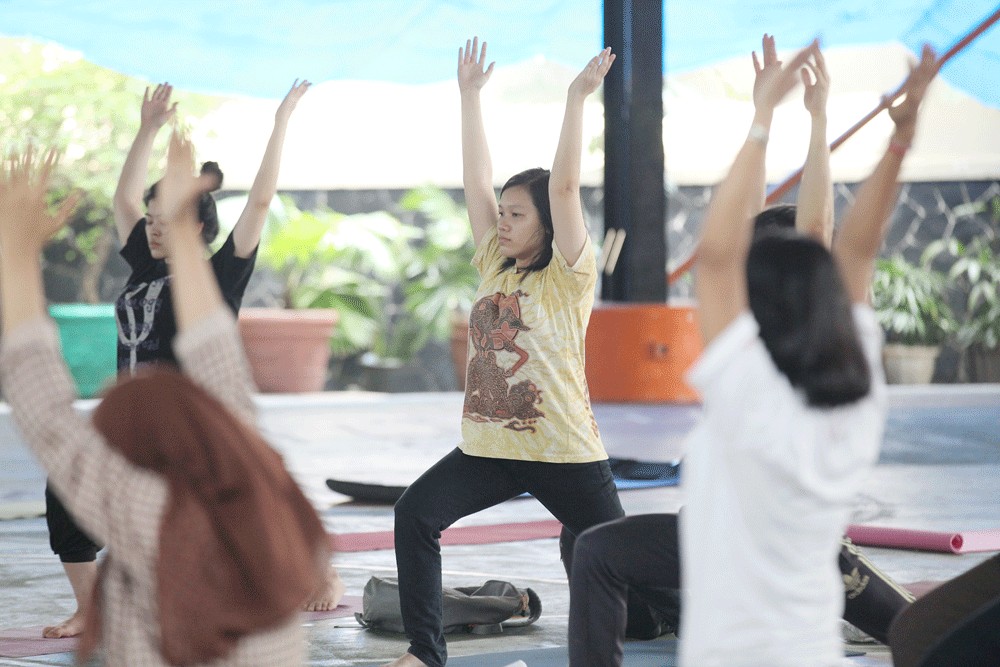Popular Reads
Top Results
Can't find what you're looking for?
View all search resultsPopular Reads
Top Results
Can't find what you're looking for?
View all search resultsWe can end AIDS in women and children if we follow the proven path
In Indonesia, an estimated 18,000 children were living with HIV in 2022, but only 29 percent of them were receiving antiretroviral (ARV) treatment.
Change text size
Gift Premium Articles
to Anyone
 For HIV/AIDS: Several people participate in yoga therapy during the AIDS International Candlelight Festival Indonesia at Atmajaya University in Jakarta on Oct. 23, 2018. The program was organized by the Indonesia Volunteers on Improvement Change and Empowerment to raise awareness about HIV/AIDS among young people. (The Jakarta Post/Wendra Ajistyatama)
For HIV/AIDS: Several people participate in yoga therapy during the AIDS International Candlelight Festival Indonesia at Atmajaya University in Jakarta on Oct. 23, 2018. The program was organized by the Indonesia Volunteers on Improvement Change and Empowerment to raise awareness about HIV/AIDS among young people. (The Jakarta Post/Wendra Ajistyatama)
Aila, a 6-year-old girl, has been diagnosed with HIV since birth. With the support and courage of her mother, she has overcome a long journey toward a healthy life.
Every month, they face a tiring journey to the hospital, encountering stigma from the surrounding community. However, her mother never gives up.
Currently, Aila has two younger siblings, both HIV-negative, as her mother has enrolled in a Prevention of Mother-to-Child Transmission (PMTCT) program provided by the government. Aila's mother is also active in advocating for awareness and protection for children living with HIV by being involved in the Lentera Anak Pelangi community.
Aila's story reflects a clear example of how addressing inequality by providing access to appropriate care for children can save precious lives and prevent AIDS. This is also emphasized in the new Joint United Nations Program on HIV/AIDS (UNAIDS) Global AIDS Update report titled The Path to End AIDS, which has just been released.
The report demonstrates that there is a path to ending AIDS. Taking the path that ends AIDS, will also help ensure preparedness to address future pandemic challenges, and advance progress across the Sustainable Development Goals.
The data and real-world examples set out in this report make it very clear what that path is. It is not a mystery. It is a political and financial choice. HIV responses succeed when they are anchored in strong political leadership to follow the evidence, tackle the inequalities holding back progress, ensure sufficient and sustainable funding and enable communities and civil society organizations in their vital role in the response.
These examples of putting people and communities first demonstrate how together we can end AIDS as a public health threat by 2030. As the report sets out, however, none of this will come automatically.
While access to HIV treatment has helped save 20.8 million lives globally, these life-saving advances are still being denied to millions of people who urgently need them. AIDS claimed a life every minute in 2022. There were 1.3 million new HIV infections, and 9.2 million people are still missing out on treatment, including 43 percent of children living with HIV.
The pandemic’s ongoing cost to children is among the most painful reminders that AIDS is not over. Even though AIDS-related deaths among children (0-14 years) were reduced by 64 percent globally between 2010 and 2022, the epidemic still claimed the lives of an estimated 84,000 children in 2022.
It is vital to ensure that children are diagnosed, and life-saving treatment is provided to some 660,000 children. In Indonesia, an estimated 18,000 children were living with HIV in 2022. However, only 29 percent of them were receiving antiretroviral (ARV) treatment, lower than ARV coverage for adults, which reached 33 percent in the same year.
Ongoing social and economic inequalities are exacerbating and prolonging pandemics and amplifying their impact on the poorest and the most vulnerable, including women and adolescent girls.
Globally, 4,000 adolescent girls and young women aged 15-24 years old are newly infected with HIV every week. Deeply entrenched gender inequalities and discrimination, often combined with significant levels of poverty, increase their risk of HIV infection.
It is vital to advance safe societies so that young women can protect their health and wellbeing. In Indonesia, young women aged 15-24 years old accounted for 4,800 new HIV infections in 2022, or 20 percent of the total new HIV infections.
While neighboring countries such as Thailand and Cambodia are close to achieving the 95-95-95 targets, Indonesia is still not on that path. Of the estimated 540,000 people living with HIV (PLHIV) in Indonesia, only 79 percent of them know their HIV status, and even more concerning, only 33 percent were receiving ARV treatment.
Similarly, Indonesia has the lowest coverage of ARV treatment for pregnant women in Asia after only the Philippines, Pakistan and Afghanistan. In 2022, only 18 percent of pregnant women living with HIV in Indonesia received antiretroviral therapy to prevent mother-to-child transmission. This figure is significantly low when compared to regional (57 percent) and global (82 percent) coverage.
In our efforts to end AIDS, we need to ensure that no one is left behind, including women, children and adolescents. Focus should be placed on prevention by increasing the knowledge and participation of PLHIV and affected communities, facilitated by user-friendly technology and information.
Children and adolescents living with HIV are not merely subjects of public policy, but rather active participants who influence appropriate programs and services. By acknowledging their voices and agency, we need to ensure that supply and demand are connected.
One concrete step taken by Indonesia is by establishing the National Alliance to End AIDS in Children. This alliance seeks to provide protection, access to health services and support needed by children living with HIV. Through strong collaboration between the government, civil society and international organizations, we can improve efforts to protect and treat children living with HIV.
On June 20, the alliance held a national consultative meeting involving all stakeholders and program implementers, focusing on women and children living with HIV in Indonesia.
Over 47 organizations, including civil society organizations, professional institutions, community support for children living with HIV and cross-sectoral ministries, are committed to carrying out three main functions as an alliance: first, advocacy for the needs of adolescent girls and children living with HIV, second, promotion and dissemination of information on Prevention of Mother-to-Child Transmission (PMTCT), Early Infant Diagnosis, treatment literacy and comprehensive sexual education and third, empowerment of communities regarding issues pertaining to children living with HIV.
Although women, children and adolescents are not part of the key population groups, they still need to be a primary focus in HIV prevention efforts. According to the UNAIDS report, access to accurate information about HIV and a proper understanding of HIV transmission and prevention remain challenging for the majority of adolescents. Therefore, more intensive efforts are required to provide them with education and access to accurate HIV information.
Ending AIDS is not an easy task, but we can make significant progress. We need to ensure that everyone has equal access to HIV services, including prevention and treatment. Additionally, strengthening education, understanding and technology utilization is key in equipping women and adolescents with the necessary knowledge and skills to protect themselves and prevent HIV.
The message conveyed in the UNAIDS report clearly states that we can end AIDS if we move together and take action. The way is open, now is the time to commit and act upon it. Let us realize the vision of ending AIDS and creating a better future for women, children and adolescents.
The obstacles in the way of progress are not fate. We can overcome them. The path that ends AIDS requires collaboration – South and North, government and communities, UN and member states together. And it requires bold leadership. The route map set out in UNAIDS' new report shows how success is possible, in this decade – if we move together and with urgency.
The facts and figures shared in this report do not show that as a world we are already on the path, they show that we can be. The way is clear.
***
Krittayawan Boonto is UNAIDS country director for Indonesia. Irwanto is professor at Faculty of Psychology, Atma Jaya Catholic University Jakarta and head of Anak Pelangi Lentera Foundation. Ayu Oktariani, is national coordinator of the Indonesian Positive Women's Association and Atiqah Hasiholan, a UNAIDS goodwill ambassador, also signed the article.










